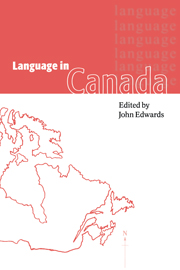Book contents
- Frontmatter
- Contents
- List of figures
- List of maps
- List of tables
- Notes on contributors
- 1 Canada
- Introduction
- 1 The foundations
- 2 The fading Canadian duality
- 3 Official bilingualism: from the 1960s to the 1990s
- 4 Official multiculturalism
- 5 Language in education: bridging educational policy and social psychological research
- 6 Aboriginal languages: history
- 7 Aboriginal languages: current status
- 8 French: Canadian varieties
- 9 French in Quebec
- 10 French in New Brunswick
- 11 French outside New Brunswick and Quebec
- 12 English: Canadian varieties
- 13 English Quebec
- 14 The teaching of international languages
- 15 French immersion in Canada
- 16 Language in Newfoundland
- 17 Language in Prince Edward Island
- 18 Language in Nova Scotia
- 19 Language in New Brunswick
- 20 Language in Quebec: aboriginal and heritage varieties
- 21 Language in Ontario
- 22 Language in Manitoba
- 23 Language in Saskatchewan: Anglo-hegemony maintained
- 24 Language in Alberta: unilingualism in practice
- 25 Language in British Columbia
- 26 Language in the Northwest Territories and the Yukon Territory
- Index of names
- Index of language families, languages, dialects
- Index of subjects
1 - The foundations
Published online by Cambridge University Press: 18 February 2010
- Frontmatter
- Contents
- List of figures
- List of maps
- List of tables
- Notes on contributors
- 1 Canada
- Introduction
- 1 The foundations
- 2 The fading Canadian duality
- 3 Official bilingualism: from the 1960s to the 1990s
- 4 Official multiculturalism
- 5 Language in education: bridging educational policy and social psychological research
- 6 Aboriginal languages: history
- 7 Aboriginal languages: current status
- 8 French: Canadian varieties
- 9 French in Quebec
- 10 French in New Brunswick
- 11 French outside New Brunswick and Quebec
- 12 English: Canadian varieties
- 13 English Quebec
- 14 The teaching of international languages
- 15 French immersion in Canada
- 16 Language in Newfoundland
- 17 Language in Prince Edward Island
- 18 Language in Nova Scotia
- 19 Language in New Brunswick
- 20 Language in Quebec: aboriginal and heritage varieties
- 21 Language in Ontario
- 22 Language in Manitoba
- 23 Language in Saskatchewan: Anglo-hegemony maintained
- 24 Language in Alberta: unilingualism in practice
- 25 Language in British Columbia
- 26 Language in the Northwest Territories and the Yukon Territory
- Index of names
- Index of language families, languages, dialects
- Index of subjects
Summary
INTRODUCTION
To contemplate a map of Canada while thinking of its languages is to induce an optical illusion. For the language boundaries do not coincide with the lines on the map – and they never have. The straight lines that separate the provinces have never been language boundaries – nor has the 3,000-mile international boundary that separates Canada from the United States. Of the many languages spoken in Canada, none is exclusively Canadian with the exception of certain Amerindian languages. These, however, belong to language families which extend into the United States; their territory in some cases straddles the international boundary line. So do the language boundaries of French and English. All the languages of Canadian immigrants can also be heard south of the border. While Canada's national and intra-national political boundaries are artificial and often arbitrary, having been created by the hazards of war or the accommodations of peace, the language boundaries of Canada have been fashioned by the movement of people, settling into a vast and sparsely populated continent.
The history of language in Canada is that of three different geolinguistic types – the native languages, the colonial languages and the immigrant languages. The development of each has long been intertwined with that of the others, since the settlement of the continent has inevitably brought one group into contact – and often into conflict – with the others: the English with the French and the Indians with both colonial settlers.
- Type
- Chapter
- Information
- Language in Canada , pp. 13 - 35Publisher: Cambridge University PressPrint publication year: 1998
- 1
- Cited by



